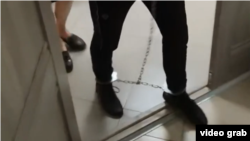In the spring of 2021, Russia's Interior Ministry placed a tender for nearly 15,000 sets of shackles at a cost of almost 70 million rubles ($1.1 million).
"Shackles are not widely used today," a source in the Interior Ministry who agreed to speak on condition of anonymity told RFE/RL when asked about the tender. "Under current circumstances, it looks crazy. People could complain about inhumane treatment.
"When transporting really dangerous criminals, such special equipment is needed," the source said. "But I do not think shackles will be widely used."
Lawyer Irina Biryukova told RFE/RL she had filed a complaint with the European Court of Human Rights regarding the use of shackles on a prisoner serving a life sentence.
Despite such assertions, the shackles have been seen on defendants in courtrooms in the mid-Volga region city of Samara, lawyers told RFE/RL. The regional Interior Ministry and prosecutors' office have not responded to their requests for clarifications.
"My clients are in court in the status of victims," Samara defense attorney Eldar Garoz said, explaining that his clients were convicted of drug possession several years ago and are currently serving prison terms. Now, however, the police officers involved in their case are themselves being tried on charges of falsifying evidence.
"The police officers are brought into court from their homes, while the victims who are serving prison terms are brought in in shackles," Garoz said.
Shackles are handcuff-like restraints that immobilize the arms and are connected by chains to similar restraints around the ankles.
"The transporting officers told me there was an order," Garoz said. "But they didn't know where the order came from. Supposedly somewhere in Rostov-on-Don there was an attack on a convoy, but now they are using shackles in Samara? And the shackles are new and shiny."
The Samara regional branch of the Interior Ministry declined to comment for this article. However, local media reports say the local ministry received the order to use the shackles in June after a prisoner named Ivan Kostyukov attacked a court officer who was transporting him out of a local courtroom, grabbed his weapon, and initiated a shoot-out with marshals. One marshal was shot several times, but has since returned to duty.
The appearance of shackles in Russian courts comes as Russia's massive military invasion of Ukraine grinds on in its seventh month and, at home, the government conducts a relentless crackdown on all forms of dissent. Thousands of people have been detained or prosecuted for anti-war statements and activities or for dissident political or social activity. Politically charged trials have become a feature of daily life in regions across the country.
Samara defense attorney Yana Gelmel has a client who, along with another defendant, is being tried for robbery and extortion. According to Gelmel, the client, who has a previous robbery conviction, was standing up for a sex worker who was being abused by a pimp and the purported pimp retaliated by pressing spurious charges.
WATCH: A video of defendants in shackles taken by lawyer Yana Gelmel:
She said her client was brought to each court session in shackles, although they were removed during the hearings.
The conveyance of prisoners is regulated by Interior Ministry instructions from 2006. Those instructions do not mention shackles and say that even handcuffs should only be used for prisoners who are regarded as escape risks, are considered particularly dangerous, or who are serving life sentences.
Other examples of the use of shackles in Samara that were mentioned by rights activists and lawyers involved either prisoners who were accused of murder or those who had already been sentenced to life in prison.
Lawyer Irina Biryukova told RFE/RL she had filed a complaint with the European Court of Human Rights (ECHR) regarding the use of shackles on a prisoner serving a life sentence. That case is still pending.
Igor, who asked that his surname be withheld for fear of retribution for speaking on a political topic, is the administrator of a Russian-language forum on handcuffs and similar forms of restraints. He said shackles were outlawed in Russia in the early 20th century but that they are now making a comeback – not just in Russia but in many countries.
"Modern handcuffs and shackles in Russia are at the level of Central European products in terms of functionality and safety," Igor said. "Sometimes, though, they are inferior in terms of precision manufacturing."
In the past, Russia has been criticized by international rights groups and the ECHR for placing defendants in cages during their trials. In 2014, the ECHR ruled the use of cages was "an affront to human dignity" and "incompatible with the standards of civilized behavior."
It continues to be common practice in Russia.












